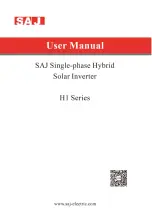
Technical Manual
WDGA with CANopen-Interface
5 - General information about CAN
© Wachendorff Automation GmbH & Co. KG
15
Rev.1.24
PDOs will not be acknowledged and are suitable for time critical applications.
By using the full 8 bytes for data, there is no additional information about transmitted
objects. Therefore the PDO producer and the PDO consumer have to define the PDO-
mapping.
PDOS can be sent on different ways:
On request:
A node sends a RTR frame to ID of the designated PDO and the
encoder returns the PDO. (The CiA strongly recommends not to use RTR
frames. Therefore RTR is not supported by Wachendorff Automation encoders!)
Synchronously:
On the reception of a SYNC message the node send its
PDOs.
Asynchronously:
The sending of the PDOs is triggered by an internal event
(e.g. the internal event timer).
5.3.3 Object dictionary
The object dictionary lists all data types, objects and functions of the communication
and the device profile. There are also manufacturer specific objects listed. The objects
are addressed by 16-bit indices (lines) and 8-bit sub-indices (columns).
Table 5.3 shows the structure of the object dictionary:
Index(hex)
Object description
0000
reserved
0001 001F
static data types
0020 003F
complex data types
0040 005F
manufacturer specific data types
0060 007F
profile specific static data types
0080 009F
profile specific complex data types
00A0 0FFF
reserved
1000 1FFF
communication profile objects
2000 5FFF
manufacturer specific objects
6000 9FFF
objects from the "Standard device profiles"
A000 AFFF
network variables
B000 FFFF
reserved / system variables
Table 5.3: Structure of the object dictionary
Содержание WDGA CANopen
Страница 1: ...R e v 1...
















































